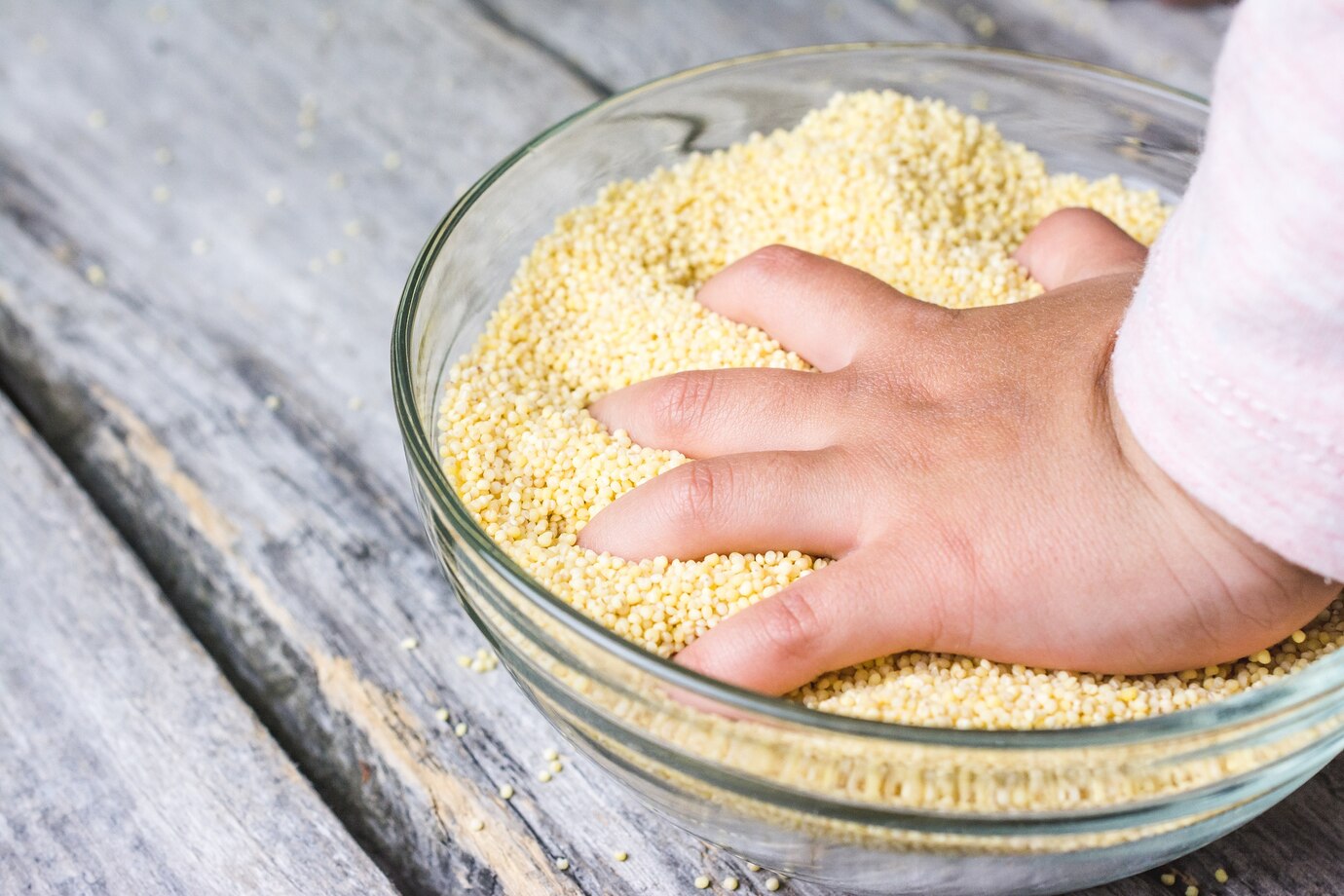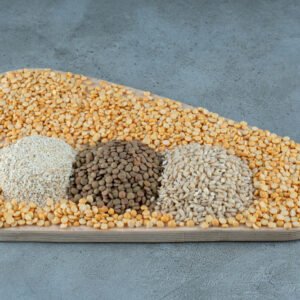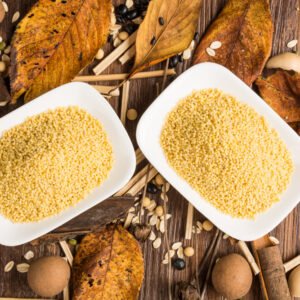Introduction to Finger Millet and Diabetes
Diabetes is one of the most prevalent chronic health conditions in the world today, affecting over 537 million adults globally. With rising blood sugar levels and complications such as cardiovascular diseases, kidney damage, and nerve problems, managing diabetes requires a holistic approach that includes medication, physical activity, and most importantly, diet. One traditional superfood that has emerged as a powerful ally in the fight against diabetes is finger millet, commonly known as ragi.
In this comprehensive guide, we will explore the benefits of finger millet for diabetes, its nutritional profile, how it compares with other grains, recipes suitable for diabetics, and the latest scientific research supporting its use in diabetic diets.
What Is Finger Millet (Ragi)?
Finger millet, or Eleusine coracana, is an ancient cereal grain cultivated mainly in India and Africa. It is a hardy crop that thrives in arid conditions and poor soils, making it a sustainable grain for farming communities. In India, it’s known as ragi in Karnataka, nachni in Maharashtra, and mandua in North India.
Nutritional Composition
Finger millet stands out due to its impressive nutritional profile:
- Rich in Dietary Fiber
- Low Glycemic Index (GI)
- High in Calcium, Iron, and Potassium
- Gluten-Free
- High Polyphenol and Antioxidant Content
These characteristics make it particularly beneficial for managing diabetes.
Why Finger Millet for Diabetes?
Diabetes management requires foods that prevent blood sugar spikes, provide sustained energy, and support overall health. Ragi excels in these areas due to its:
- Low Glycemic Index: Slow sugar release prevents glucose spikes.
- High Fiber Content: Enhances insulin sensitivity and digestion.
- Nutrient Density: Supports heart health, weight management, and immunity.
- Gluten-Free Nature: Safe for diabetics with gluten intolerance.
CMS Industries’ ragi, processed to retain maximum nutrients, delivers these benefits, making it a cornerstone of diabetes-friendly diets.
Benefits of Finger Millet for Diabetes
Ragi’s unique nutritional profile offers multiple benefits for diabetes management. Below are the top 10 benefits of finger millet for diabetics, supported by science and practical applications:
- Low Glycemic Index for Blood Sugar Control
Ragi’s GI of 50-55 ensures slow carbohydrate absorption, preventing rapid blood sugar spikes. This helps maintain stable glucose levels, reducing the need for insulin surges.
How It Helps: CMS Industries’ ragi supports steady blood sugar with low-GI grains.
- High Fiber Enhances Insulin Sensitivity
Ragi contains 3.6g of fiber per 100g, which slows glucose absorption and improves insulin sensitivity. Fiber also reduces post-meal glucose spikes, crucial for type 2 diabetes.
How It Helps: CMS Industries’ ragi promotes insulin efficiency with fiber-rich grains.
- Supports Weight Management
Obesity is a risk factor for diabetes. Ragi’s fiber promotes satiety, reducing overeating, while its complex carbohydrates provide sustained energy, preventing hunger-driven glucose fluctuations.
How It Helps: CMS Industries’ ragi aids weight control for diabetic health.
- Rich in Antioxidants to Reduce Inflammation
Ragi’s polyphenols and ferulic acid combat oxidative stress and inflammation, common in diabetes. These antioxidants protect against diabetic complications like neuropathy and cardiovascular issues.
How It Helps: CMS Industries’ ragi reduces inflammation with antioxidant-packed grains.
- Improves Heart Health
Diabetes increases heart disease risk. Ragi’s fiber, magnesium (137mg/100g), and polyphenols lower LDL cholesterol and regulate blood pressure, protecting cardiovascular health.
How It Helps: CMS Industries’ ragi supports heart health for diabetics.
- Prevents Digestive Issues
Diabetics often face gastroparesis or constipation. Ragi’s insoluble fiber promotes regular bowel movements and supports gut health, reducing digestive complications.
How It Helps: CMS Industries’ ragi enhances digestion with fiber-rich grains.
- High Calcium for Bone Health
Diabetes can weaken bones. Ragi’s calcium (344mg/100g) strengthens bones, reducing osteoporosis risk, especially for older diabetics on long-term medication.
How It Helps: CMS Industries’ ragi fortifies bones with calcium-rich grains.
- Iron for Energy and Anemia Prevention
Ragi’s iron (3.9mg/100g) boosts hemoglobin, combating fatigue and anemia, common in diabetics due to nutrient deficiencies or chronic inflammation.
How It Helps: CMS Industries’ ragi fights anemia with iron-packed grains.
- Gluten-Free for Sensitive Diets
Many diabetics have gluten intolerance or celiac disease. Ragi’s gluten-free nature makes it a safe, nutrient-dense alternative to wheat-based foods.
How It Helps: CMS Industries’ ragi supports gluten-free diabetic diets with pure grains.
- Sustainable and Affordable Nutrition
Ragi’s drought-resistant cultivation ensures affordability and accessibility, making it a practical choice for diabetics globally. Its sustainability aligns with eco-conscious eating.
How It Helps: CMS Industries’ ragi offers sustainable, budget-friendly nutrition.
Scientific Studies Supporting Finger Millet for Diabetes
Study 1: Indian Journal of Medical Research
- Ragi consumption showed a significant reduction in blood glucose and cholesterol in diabetic rats, confirming its hypoglycemic properties.
Study 2: Nutritional Neuroscience Journal
- Finger millet flour significantly reduced fasting blood sugar and HbA1c levels in pre-diabetic individuals over a 12-week period.
Study 3: Journal of Functional Foods
- Polyphenol-rich extracts from finger millet improved insulin signaling and reduced glucose absorption in human cell studies.
These findings back the traditional wisdom surrounding ragi’s benefits.
How to Incorporate Ragi into a Diabetic Diet
Ragi’s versatility makes it easy to include in diabetic-friendly meals. Here are practical ways to enjoy it:
- Ragi Roti: Mix ragi flour with water for low-GI flatbreads, paired with low-glycemic vegetables or lean proteins.
- Ragi Porridge: Cook ragi flour with water or unsweetened almond milk for a fiber-rich breakfast, flavored with cinnamon.
- Ragi Dosa: Blend ragi with urad dal for crispy dosas, served with sambar or chutney for balanced meals.
- Ragi Malt: Prepare a low-sugar health drink with ragi flour and water, ideal for snacks.
- Ragi Soup: Use ragi flour as a thickener in vegetable soups, adding fiber and nutrients.
Why Choose CMS Industries for Finger Millet?
As a trusted agricultural products supplier in India, CMS Industries delivers quality and sustainability. Here’s why we’re the preferred choice:
- Premium Quality: Our ragi is sourced from trusted farmers and tested for purity and nutrient content.
- Sustainable Sourcing: We support eco-friendly farming, minimizing environmental impact.
- Global Reach: Our efficient supply chain delivers fresh ragi to markets worldwide.
- Customized Solutions: We offer whole ragi, flour, and processed products tailored to diabetic needs.
- Expert Support: Our team provides recipes and guidance for diabetes-friendly ragi use.
Ragi’s Role in a Holistic Diabetic Lifestyle
Managing diabetes involves diet, exercise, and lifestyle changes. Ragi supports this holistic approach:
- Diet: Low GI and high fiber stabilize blood sugar and promote satiety.
- Exercise: Ragi’s iron and protein provide energy for physical activity, improving insulin sensitivity.
- Sustainability: Eco-friendly cultivation aligns with mindful living, reducing stress.
Potential Side Effects and Precautions for Diabetics
Ragi is generally safe for diabetics, but consider these precautions:
- Moderation: High fiber may cause bloating; start with 50-100g daily.
- Oxalates: High oxalate content may affect kidney stone patients; consult a doctor.
- Portion Control: Balance with low-GI foods to avoid carbohydrate overload.
- Allergies: Rare, but test for sensitivity if new to ragi.
Tips for Maximizing Ragi’s Benefits for Diabetes
To optimize ragi’s benefits, follow these expert tips:
- Pair with Low-GI Foods: Combine ragi with vegetables, lentils, or lean proteins for balanced meals.
- Soak Before Cooking: Soaking enhances digestibility and nutrient absorption.
- Avoid Sugary Additives: Use natural spices or herbs instead of sugar in ragi recipes.
- Monitor Portions: Stick to 1-2 rotis or ½ cup porridge per meal to control carbs.
- Choose Quality: Select CMS Industries’ ragi for purity and nutrient retention.
Ragi vs. Other Grains for Diabetes
Compared to other grains, ragi stands out for diabetics:
- Vs. Wheat: Ragi is gluten-free and has a lower GI (50-55 vs. 70).
- Vs. Rice: Ragi’s fiber and nutrients surpass white rice’s high GI (89).
- Vs. Bajra: Similar GI, but ragi offers more calcium and antioxidants.
The Future of Finger Millet for Diabetes Management
Ragi is gaining traction in diabetic nutrition:
- Functional Foods: Incorporated into low-GI snacks, cereals, and health drinks.
- Global Awareness: Rising in gluten-free and diabetic-friendly diets worldwide.
- Research Advances: Studies continue to validate ragi’s role in glycemic control.
- Sustainable Diets: Aligns with eco-friendly eating, appealing to health-conscious consumers.
Conclusion
Finger millet is more than just a traditional grain, it is a functional food powerhouse that offers remarkable benefits for individuals with diabetes. From stabilizing blood sugar to reducing oxidative stress, ragi has proven its worth in both traditional diets and modern scientific research.
With increasing awareness and demand for diabetes-friendly foods, finger millet stands out as a sustainable, affordable, and highly nutritious choice. Whether you’re managing blood sugar levels or simply looking to eat healthier, adding finger millet to your daily routine can bring life-changing results.
Explore the range of finger millet products by CMS Industries to take the first step toward a healthier, more balanced lifestyle.
Frequently Asked Questions (FAQs)
- How does finger millet help with diabetes?
Ragi’s low glycemic index and high fiber stabilize blood sugar and enhance insulin sensitivity. CMS Industries’ ragi supports diabetes management with nutrient-rich, gluten-free grains for steady energy.
- Can ragi replace wheat for diabetics?
Yes, ragi’s gluten-free nature and lower GI make it a better choice. CMS Industries’ ragi flour offers a nutrient-dense alternative for diabetic-friendly rotis and dosas.
- How much ragi should diabetics consume daily?
Diabetics can consume 50-100g of ragi daily, like 1-2 rotis. CMS Industries’ ragi ensures nutrient-rich portions, balanced with low-GI foods for optimal glycemic control.
- Why choose CMS Industries for ragi for diabetes?
CMS Industries offers sustainably sourced, high-quality ragi, tested for purity. Our nutrient-dense grains support diabetic health, trusted globally for excellence and eco-friendly nutrition.
- What ragi recipes are best for diabetics?
Ragi rotis, porridge, and dosas with low-GI ingredients are ideal. CMS Industries’ ragi flour inspires diabetes-friendly recipes, adding fiber and nutrients to balanced meals.





